
The Reserve Bank board will be stripped of its power to set interest rates and replaced by a board of monetary policy experts under the biggest shake-up to Australia’s economic policy settings in a generation.
Treasurer Jim Chalmers will on Thursday release the independent review of the RBA, which recommends that the current board focus should be on the operation of the bank rather than the setting of interest rates every month.

The change would bring the Reserve Bank into line with its international peers such as the Bank of England while ending a system that was first proposed during the Great Depression. It would be the largest shake-up to the bank since it started targeting inflation in the early 1990s.
The governor of the RBA will also front a press conference after meetings to publicly explain the bank’s decisions.
It is not yet known if the government or the board will appoint the specialist board and the governor’s role on it is not confirmed.
The review, the first outside examination of the bank since the early 1980s, was prompted by a Sydney Morning Herald and Age investigation that showed concerns about how the bank was operating monetary policy before the COVID-19 pandemic.
Anger over the bank has intensified since then after the RBA started tightening monetary policy in May last year, having earlier signalled it would hold official interest rates at 0.1 per cent until 2024.
Chalmers will announce in-principle agreement with all 51 recommendations made by the review panel made up of international monetary policy expert Carolyn Wilkins, who sits on the Bank of England’s financial policy committee; the interim director of the Crawford School at the Australian National University, Renee Fry-McKibbin; and the secretary for public sector reform Gordon de Brouwer.
The recommendations include affirming the RBA’s independence from the government of the day and its overriding policy aim to keep inflation between 2 and 3 per cent.
Chalmers said the panel had delivered a significant piece of work and noted he would work across the parliament to implement its recommendations.
The biggest shake-up of the RBA since the 1990s will be announced today with Treasurer Jim Chalmers expected to strip the board’s powers to set interest rates.
“The review is all about ensuring Australia’s central bank and monetary policy arrangements are as strong and effective as they can be into the future,” he said.
Unlike most central banks, monetary policy is set by the RBA’s board of non-monetary policy experts, an idea first proposed by Great Depression-era Labor treasurer Ted Theodore.
Most central banks have moved to separate monetary policy committees while the operation of the bank itself is left to the governor or a board of directors similar to a private company.
Any move to a separate monetary policy specialist committee would likely require changing the RBA’s operating legislation. Changing the RBA Act would put pressure on both the government and Coalition to take a bipartisan approach to reforming the bank.

Shadow treasurer Angus Taylor, who has held his own briefings with the review panel, received a copy of the report earlier in the week.
Taylor said it was vital to Australia that it had an independent, credible and capable Reserve Bank.
“It is essential the review’s recommendations are agreeable for both major parties. This will ensure certainty around the outcome of this review. With inflation at its highest level in decades, this in the best interests of Australians,” he said.
Outside of interest rates, the RBA board oversees the payments system and is currently debating the use of cryptocurrencies and the creation of a central bank digital coin.
In other countries with specialist committees of monetary policy experts, central banks usually meet every six to eight weeks. The Reserve currently meets every month.
At present, governor Philip Lowe – whose seven-year term is due to end in September – and deputy Michelle Bullock have prime responsibility for outlining the bank’s view on interest rates. Moving to a specialist committee would enable members to outline their own perspectives on the economy and monetary policy.
The review is expected to recommend changes to the bank’s communication strategy and other internal operational matters that will not require reforms to the RBA’s 1959 legislation.
Some of the recommendations will require work with the Council of Financial Regulators, which is made up of the Australian Prudential Regulation Authority, Treasury and the Australian Securities and Investments Commission, and an agreement on a new statement on the conduct of monetary policy.
The statement, between the RBA governor and the treasurer of the day, contains the bank’s inflation target.
There will be some immediate changes to the bank. Long-standing board members Wendy Craik and Mark Barnaba, both appointed by then-treasurer Scott Morrison and whose terms are due to end in the next four months, did not seek to continue their positions.
Chalmers will announce their replacements on Thursday.
These will be the first new board members since Chalmers opened up the appointment process to the general public.
